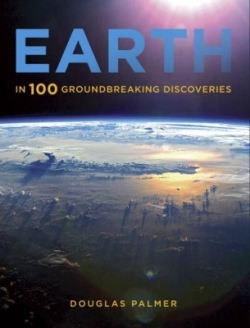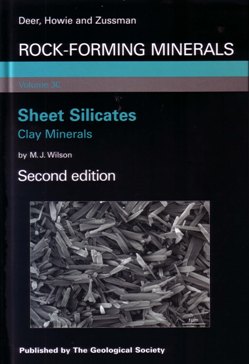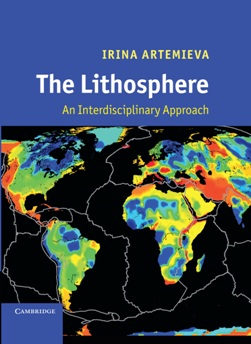 Earth in 100 Groundbreaking Discoveries
Earth in 100 Groundbreaking Discoveries
Recently, a friend sheepishly returned this book to me. “Sorry, seem to have had it for quite a while”, he said as he handed it over. A piece of paper fell out which said “Dear Mrs Kenny, Thank you for agreeing to review this book…”. “What did you write?” asked my friend. The polite version of my reply was that the book had not been in my hands long enough for me to review it.
This is one of this book’s defining characteristics. It’s nice-looking, easy to pick up; you can dip into it at random and flick through its beautiful illustrations and it’s almost impossible not to find something that grabs your attention. The stories about each chosen discovery are entertaining and before you know it, the person who has picked it up is settled in a chair with it, and then – ‘borrowing’ it.
Despite a strong Earth science/geology slant there is no technical jargon and it has appealed to a wide range of people passing through my lounge. It’s like a bound copy of an annual subscription to National Geographic, but without all the adverts for aspirational photography equipment. By the very nature of the book the articles are generally short and occasionally lacking in detail (for example the book contains the only article about the Burgess Shale that I have ever read that does not mention Hallucigenia), but conversely, it is the short ‘taster’ nature of the articles that make it so easy to dip in and out.
This makes it ideal reading for (as demonstrated) coffee tables, or for people like myself, as a working parent of two small children, whose reading time is often constrained to the run-time of an episode of Peppa Pig, bathroom breaks and the 10 minutes between actually getting into bed and sleeping. It’s full of celebratory wonder at the amazing planet we call home, and in these often miserable times of double-dip recession and climatic disruption, it is good to step back and take a look at our tiny problems from the vast perspective of our geological past, but also to know that there’s stuff worth saving out there.
It’s also a solidly constructed, fairly heavy book, good for use as a bludgeon to threaten a friend who has “borrowed” it for so long it probably counts as stolen.
Reviewed by Catherine Kenny
EARTH IN 100 GROUNDBREAKING DISCOVERIES
DOUGLAS PALMER
Published by Quercus Publishing 2011 ISBN 978-0-85738-501-7 416 pages List price £15.00 www.quercusbooks.co.uk
 Sheet Silicates – Clay Minerals: Rock-Forming Minerals
Sheet Silicates – Clay Minerals: Rock-Forming Minerals
This long awaited 2nd edition to Deer, Howie and Zussman’s landmark Rock-Forming Minerals series, presents a significant revision and re-organisation of the volume on these important sheet silicate minerals. The edition reflects the fundamental advances made in clay mineral science during the period since the initial publication in 1961.
Beginning with an introductory overview to the clay minerals (describing the clay mineral ‘concept’, their structure/classification, identification/characterisation, origin, occurrence, distribution and applications), each group is described and presented in separate chapters in the established format of the RFM series: structure, chemistry, optical and physical properties, distinguishing features and paragenesis. This edition also places more emphasis on special clay-like properties such as ion-exchange, adsorption, their ability to form organic complexes, interactions with water and colloidal characteristics.
In common with the 1st edition, the clay minerals are described in a chapter on each of the Kaolin, Smectite and Mica Clay (Illite) groups and on Vermiculite. This edition additionally includes separate chapters on mixed-layer and inter-layered clay minerals, and the Palygorskite and Sepiolite clay minerals. The chapter on mixed-layer clay minerals examines the contentious issue of the physical nature of the random and long-range ordered phases, with an extensive review of the current XRD and electron microprobe evidence for the various structural interpretations for the mode of origin for these clays.
The focus of the second edition is largely on the nature and occurrence of the clay minerals in a mineralogical and geological context. However, the volume reflects the fact that clay mineralogy is an interdisciplinary science, with considerable reference to the research progress made in many other complimentary science disciplines, including soil science, environmental science and engineering, colloid chemistry and ceramic/material sciences.
Primarily aimed at sedimentary geologists, mineralogists and soil scientists, researchers in related fields will find this revision an essential reference work.
The volume is exceptionally well written, with clear and appropriate figures, diagrams and XRD, microprobe and mineral-chemical data-tables. The author is to be congratulated on an excellent revision, which will remain as the foremost research reference work in the field for many years to come.
Reviewed by Mark Griffin
SHEET SILICATES – CLAY MINERALS: ROCK-FORMING MINERALS v. 3C (SECOND EDITION) DEER, HOWIE and ZUSSMAN
By M J Wilson 2013. The Geological Society of London.
ISBN 978-1-86239-359-2 hbk 724pp. ISSN 2041-6296 List Price: £120.00
 The Self-Potential Method
The Self-Potential Method
The self-potential (SP) method is the ugly duckling of modern applied geophysics. Initially developed for mineral exploration, and recording some spectacular early successes, it inevitably fell into disfavour once it had been shown that many ore-bodies that were easily detectable by other electrical means produced no SP response. The equipment is cheap, but noise levels are often high and the precautions needed to obtain good-quality results are all too often neglected. The difficulties are most severe in environmental applications, where anomalies are seldom more than a few tens of millivolts and may well be lost in the noise.
Bravely, Revil and Jardani have set out to counter the prevailing negative views, and to do so by adopting an uncompromisingly mathematical approach. The titles of the eight chapters seem innocent enough (‘Fundamentals’, ‘Development of the Theory’, ‘Laboratory Investigations’, ‘Forward and Inverse Modelling’, ‘Applications to Geohazards’, ‘Applications to Water Resources’, ‘Applications to Hydrothermal Systems’ and, finally, ‘Seismo-Electric Coupling’) but few pages pass without at least one equation, often of startling ferocity. Fortunately, the prose style is generally lucid and even readers who are unable to follow the mathematics have much to gain from the text. Practical considerations are not neglected, and the case histories chosen are relevant and adequately documented. Their treatments in the book are not always comprehensive, but the original papers can be used by anyone wishing to take things further.
In line with the book’s subtitle, the use of SP surveys in mineral exploration is considered only very briefly, and the SP logs familiar in the oil industry (where the effects observed are actually caused by the presence of the borehole and the drilling fluid) are not discussed at all. However, the oil industry is not completely ignored. The cutting-edge seismo-electric research described in the last chapter may well come into its own with the increased use of ‘fracking’ of low-permeability gas reservoirs.
One pleasing aspect of the book is that Cambridge UP have not followed their practice (in at least one recent applied geophysics text) of relegating colour illustrations to a supporting website. Where colour is needed, colour is supplied and several of the case studies would have been incomprehensible without it.
It is, perhaps, hard to share completely the optimism of the writer of the foreword, when she claims that the book will “undoubtedly lead to more acceptance of the self-potential method”. Nevertheless, it should.
Reviewed by John Milsom
THE SELF-POTENTIAL METHOD: THEORY AND APPLICATIONS IN ENVIRONMENTAL GEOSCIENCES.
ANDRÉ REVIL & ABDERRAHIM JARDANI. Published by Cambridge University Press: 2013 ISBN 978-0-107-01927-0. 369 pp.
UK List Price £75 www.cambridge.org/revilandjardani
 The Lithosphere: an interdisciplinary approach
The Lithosphere: an interdisciplinary approach
This is an impressive volume. From the eye-catching cover design to the integrated style of the book, it is a well crafted compilation of our current knowledge of the lithosphere, its composition and structure. The interdisciplinary approach makes it particularly attractive for those geoscientists who have never really got to grips with the other lithospheric disciplines that might just be of use (as a geochemist myself, the geophysical aspects of the book are very approachable and, for the non-specialist, the level of the geochemistry content seems appropriate).
The individual chapters cover a wide range of topics, including geophysical, geochemical and structural aspects of the lithosphere. Individual chapters dedicated to specific subjects include, for example, the thermal state, the age, flexure and rheology, electrical conductivity, and the seismic structure of the lithosphere; but within each chapter the evidence is presented for what constitutes the state of the art. This comprises a wide range of separate, yet integrated strands drawing on the geophysical, geochemical and petrological literature. Where a particular line of argument is pursued, the evidence is cited; its strengths and weaknesses are discussed and complemented by discussion from other geoscience disciplines with no apparent bias. The discussion of the differences (and similarities) between the thermal, chemical, mechanical and rheological boundary layers is particularly well handled using this format which draws on a wide range of petrological, geochemical and geophysical evidence.
The book is well illustrated throughout and, beyond the introductory chapters, there is rarely a double page without an insightful figure. The format is easy to dip into, with a good number of tables summarising key points from which the reader can quickly assemble important references for further investigation. The references cited are plentiful and appropriate, ranging from the to more contemporary articles which together provide opportunities for impressive amounts of further reading.
This book is probably most appropriate for graduate students, researchers and professionals needing a one-stop volume for all things lithospheric. There is no mistaking what this volume is going to tell you – it is 773 pages of non-stop lithosphere that is surprisingly difficult to put down, despite its weight.
Reviewed by Jason Harvey
THE LITHOSPHERE AN INTERDISCIPLINARY APPROACH
IRINA ARTEMIEVA.
Published by Cambridge University Press, 2011. 773pp. ISBN 9780521843966. List price £90.00
www.cambridge.org